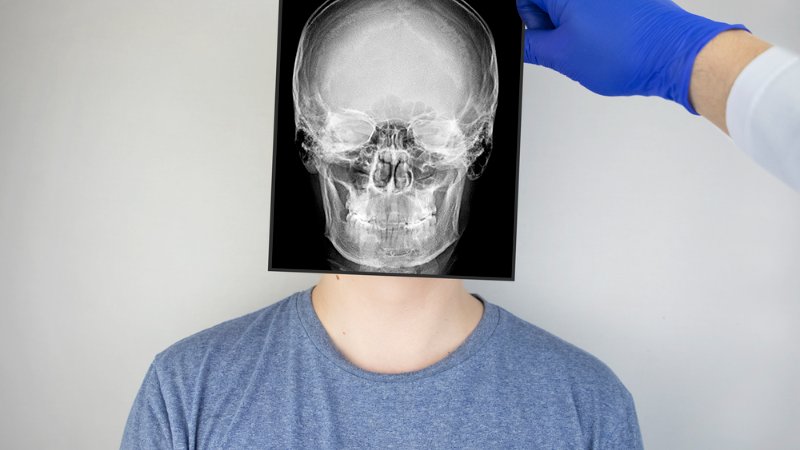A court case involving two Wisconsin schoolboys set the standard for the eggshell skull rule, and it’s as relevant now as it was more than a century ago.
This longstanding doctrine in personal injury law protects people with pre-existing conditions. It states that defendants can be liable for injuries they cause and those they make worse.
This principle has much to unpack — learning more about it can help you understand the nuances.
Explaining the Eggshell Skull Rule

You may hear other names for this convention, including the eggshell-plaintiff rule, thin-skull rule, papier-mâché-plaintiff rule, and talem qualem rule. The names come from a hypothetical example; someone with a thin skull may sustain a more severe head injury in an accident than a person with a typical skull.
Background and Origins
The rule comes from an 1890 case between two schoolboys, Vosburg v. Putney. Although it may be obscure to many, it is a landmark case and familiar to law school students.
George Putney slightly kicked Andrew Vosburg during class to get his attention in 1889. Although Putney wasn’t acting maliciously, Vosburg was recovering from a previous leg injury near the spot where Putney kicked him. The kick exacerbated the injury, and as a result, Vosburg lost the use of his leg.
The courts ruled that although Putney’s kick intended little or no harm, it was unlawful because it occurred during class. Vosburg won the case, and Putney was liable for all damages resulting from the kick.
Vosburg v. Putney has applications for civil tort laws, which deal with recovering damages for unforeseeable and unintended harm. While Putney only kicked Vosburg to get his attention, he did intentionally kick him. Therefore, Putney was liable because the kick caused Vosburg’s permanent injury.
Example of the Eggshell Skull Rule in Action
Say a person is grocery shopping in Avondale when an unmarked spill causes him to slip and fall, for example. The victim, who has hemophilia, sustains heavy bruising and bleeding. He files a lawsuit against the store to pay for his medical expenses and time away from work.
Can the store owners claim less responsibility because the victim had a pre-existing condition? According to the rule, they cannot. Therefore, the store owners are responsible for all the victim’s damages. It is the case even though a person without hemophilia may not have suffered the same injuries.
A common phrase to describe this principle is, “You must take victims as you find them.” Lord Justice Lawton used the phrase in a 1975 court case.
How the Rule Applies to Personal Injury Cases

Although it’s a widely used standard, applying the eggshell skull rule can get tricky. Every state uses it to some degree but applies it in different ways. Also, every personal injury case is unique. The rule’s application changes based on the facts of the case and the way the state interprets it.
Physical Injuries
All states apply the eggshell plaintiff rule to physical injuries. It puts the burden of compensation on the person who caused harm rather than holding the victim responsible.
Many victims would carry significant financial burdens if the rule did not apply. They would have to pay for hospital bills, medications, and therapy. They would also have to cover for their lost wages and earning potential.
After all, not every victim is in perfect health. Many people go about their daily business while living with various health conditions. There are rarely times to predict when something may happen to exacerbate them. The eggshell skull rule protects the injured person from discrimination because of a previous injury or condition.
Mental Injuries
Some pre-existing conditions are mental and emotional. An accident can intensify conditions such as anxiety, depression, and PTSD (post-traumatic stress disorder). The victim may require counseling, therapy, or medication to treat conditions the accident made worse.
The victim may also miss work. These factors lead to the same types of expenses as physical injuries.
How Arizona Uses the Rule
While some states don’t apply the eggshell plaintiff rule to mental and emotional damages, Arizona allows it. Consider the Avondale grocery shopper in the example above. If he had generalized anxiety disorder and the fall exacerbated it, the grocery store may be liable for compensation for his treatment and mental anguish.
How Using the Eggshell Skull Rule in a Claim May Be Tricky
The eggshell plaintiff rule is well established and has been successful in many cases since Vosburg v. Putney in 1890. Victims whose previous conditions exacerbate their injuries have the right to pursue total compensation. However, using the rule isn’t always straightforward, and a personal injury attorney can provide support.
An Insurance Company’s Tactics To Pay Less
Insurance companies may claim that although an accident caused a previous condition to worsen, the accident is not responsible. The company may try to pay the victim as little as possible to preserve its bottom line.
Unfortunately, insurance companies often use tactics like this to save money. Our personal injury team can help people in this situation. We will work to get the plaintiff the total compensation amount possible, even when the damages include an aggravated previous condition.
Taking an Eggshell Skull Case to Court

Sometimes, despite the best efforts and strategies, you cannot settle claims out of court. Our personal injury attorney can take the case to trial in those situations.
Jury Instructions
The plaintiff’s attorney may ask the judge to give the jury special instructions regarding the eggshell skull rule.
Variations of Jury Instructions by State
States have different wording for jury instructions in eggshell plaintiff cases. Some address it in more detail, but the concept remains the same. However, states that do not allow compensation for previous mental and emotional conditions do not contain instructions for it.
“Unusually Susceptible Plaintiff” Instructions in Arizona
In Arizona, the instructions may apply to an “unusually susceptible plaintiff” or a person with a previous condition. The jury instructions may have wording like this: If the plaintiff had a pre-existing condition that the defendant’s actions aggravated or made worse, they must decide the total amount that would reasonably and fairly compensate the plaintiff for the aggravated or worsened condition.
Additionally, the judge may tell the jury they must decide this amount even if the plaintiff was more susceptible to injury than a normally healthy individual would have been and if a normally healthy person wouldn’t have sustained a similar trauma.
The Importance of Proper Jury Instructions
Providing the correct instructions to the jury in a personal injury case can be vital, especially if the eggshell skull rule applies. If the jury does not receive the proper instructions, it can lead to an appeal.
Proving Pain and Suffering Damages in an Eggshell Skull Case
Proving mental trauma in a claim can be challenging. Pain, suffering, and emotional damage are, by nature, difficult to quantify. Unlike a physical injury, such as a broken bone or laceration, a mental injury is often less visible. There may be some outward signs, but most mental trauma takes place on the inside.
Lowball Amounts From Insurance Companies
The insurance company knows that mental and emotional injuries are more complicated to demonstrate. The company may take advantage of that fact by offering the victim a low compensation amount.
Also, the victim may believe mental trauma is a liability. The person may think it will discredit a case.
However, the eggshell skull rule can protect the victim in these circumstances. An aggravated mental injury might not lessen a claim. Instead, the victim may receive the compensation necessary to treat it.
Getting Assistance From an Attorney
Because victims can face an uphill battle trying to demonstrate mental and emotional damage, it helps to work with an attorney. An experienced personal injury attorney who has handled similar cases can give the victim crucial support.
Proving Physical Injuries in an Eggshell Skull Case
Physical injuries are often easier to demonstrate than mental ones. This is especially true for visible ones. However, they require the same evidence mental injuries do when proving an eggshell plaintiff case.
Laying the Foundation for a Physical or Mental Trauma Claim
The victim and attorney will need to prove a few points to support the eggshell skull rule:
- The condition existed before the accident.
- The accident worsened the victim’s physical or mental trauma.
- The victim has required treatment for physical or psychological trauma since the accident.
A doctor or therapist may provide supporting evidence. As an example, if healthcare professionals say the victim now needs more sessions or medication to treat mental trauma, this may back up the victim’s case. Likewise, if a doctor states a person’s physical injuries require surgery, therapy, or time off of work, it will support a case.
The Value of Medical Records

Thorough and accurate medical records are vital to personal injury cases, especially eggshell skull cases. They prove that a victim’s condition existed before the accident. They also show the relationship between the accident and the aggravated condition by documenting the victim’s additional treatment.
An attorney can help the victim gather evidence, including medical records, to support the case.
The Crumbling Skull Rule as a Counterpoint
A contrasting point to the eggshell skull rule is the crumbling skull rule. It is the argument that a person’s pre-existing condition may have inevitably gotten worse regardless of the accident.
The crumbling skull rule acknowledges these points:
- The victim had a pre-existing condition before the accident.
- The victim’s condition would have worsened regardless of the accident.
- The defendant is responsible for the damages the accident caused.
- The defendant does not need to compensate for something that would have happened anyway.
In other words, the defendant is responsible for compensation that restores the plaintiff to his or her original condition before the accident; that’s the eggshell skull rule in action. However, the defendant is not liable for putting the plaintiff in a better condition than before the accident.
An Example of the Crumbling Skull Rule
Consider again the Avondale grocery shopper. He files a lawsuit against the grocery store to recover damages for his injuries after an unmarked spill caused him to slip and fall. Say, for example, he also files for compensation to have experimental treatment to improve his hemophilia to reduce the heavy bleeding and bruising.
The grocery store can be liable for his slip-and-fall injuries. It may pay for medical treatment and lost wages, even though the costs go above and beyond what a person without hemophilia may require after a similar slip-and-fall incident.
However, the grocery store is not liable for the experimental treatment the victim wants. Hemophilia treatment is not related to the accident. If the treatment was a success, the grocery store’s payment for the treatment would put the victim in a better condition than before the accident. However, it is not responsible for doing so.
Examples of Injuries the Eggshell Skull Rule May Include
Any injury or condition that meets the definition can fall within the parameters of the eggshell plaintiff rule. Some types of injuries are more common than others.
Whiplash
A car accident may cause a person with pre-existing back or neck injuries to experience severe whiplash.
Facial Injuries
An accident can cause someone with previous dental problems to experience more severe mouth or jaw injuries.
Back or Spine Trauma
Victims with pre-existing back conditions may have additional injuries from a fall or car accident.
Pain and Suffering
People with previous mental conditions such as PTSD or anxiety can experience worsening symptoms after the trauma of an accident.
Call Sargon Law Group for Answers About the Eggshell Skull Rule
The eggshell plaintiff rule has helped many people recover damages after accidents made a previous condition worse. However, victims face many challenges in proving it. Dealing with the insurance company can be especially thorny regarding pre-existing conditions.
If you’ve had an accident in Maricopa County and believe the eggshell skull rule applies to you, call Sargon Law Group. Our team of personal injury attorneys in Phoenix, AZ can answer your questions and determine if you have a case. Contact our Phoenix car accident lawyers today.
